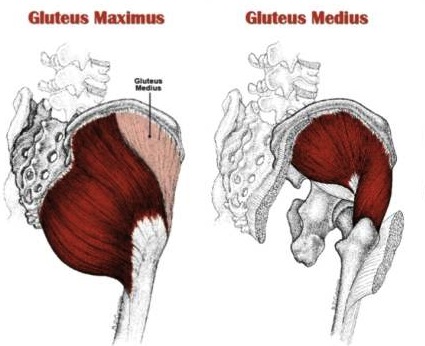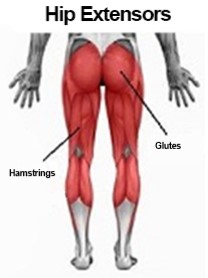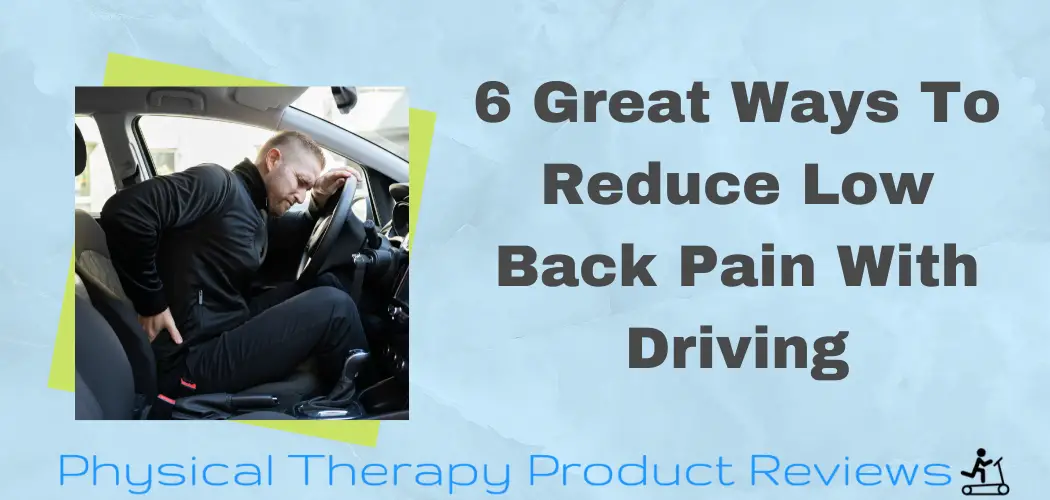Glute strengthening exercises are extremely popular and can be found all over the internet. You may want to strengthen your glutes for aesthetic reasons like toning for bikini season, for injury prevention such as reducing your risk for an ACL injury, or simply to perform better in activities such as hiking, jumping, or running. One of the easiest, quickest, yet most effective way to strengthen the glutes is using a mini loop resistance band. Our favorite bands are made by Perform Better because of their thickness and durability.
Resistance bands are optimal for glute strengthening for many different reasons:
- Easy to carry in a purse or gym bag
- Provides harder resistance the more the band is stretched
- Is easy to track progress with the various resistance levels
- Is long lasting and durable, saving you money in the long run
- Very inexpensive as compared to dumbbells and gym memberships
- Helps with time management! You may only need 10 minutes to perform these.
The majority of the glute exercises found on the internet are to targeted help tone and lift the glutes, but what if you want to prevent hip injuries? While strong hip muscles are never a bad thing, I see common problems with most of the recommendations:
- Only one muscle group or single muscle is targeted such as the glute max, potentially creating imbalance at the hip
- People are trying to perform advanced exercises before establishing proper control and stability at the hip, thus potentially increasing injury risk
- The form during this exercises is often less than desirable thus also increasing injury risk
Anatomy of the Hip
The primary hip areas to target for the best injury prevention are the hip abductors, hip extensors and hip external rotators. All strengthening of the of the hip is important, but the muscle groups listed above are the ones that are most commonly weak or inhibited for individuals with injuries within the clinic.
Hip Abductor Muscles
- The hip abductors are used primarily to keep our pelvis in a neutral alignment and to keep the pelvis level while walking and running. If you drew a line from the top of one pelvis bone straight across the body to the top of the other one pelvic bone, that’s what the hip abductors are responsible for.
- When they are weak or torn someone may walk like this, Trendelendburg Gait
Hip Extensor Muscles
- The famous muscles in the “toning” world. These muscles area fan’s favorite to write about, work on, and of course look at. This muscle group is extremely powerful and helps propel us forward during walking, running, and stairs. Also, helps with pelvic stability
- There has been a large push in recent years that our glute max has become “turned off” because we are spending more and more time in a sitting position. I think idea has some merit and have never had someone had too strong of glutes, however the pendulum may have swung too far the glute weakness over exaggerated.
Hip External Rotator Muscles
- Together all of the different muscle groups work together to control our bodies rotating around our
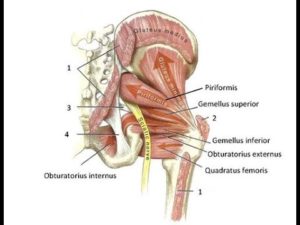 pelvis while we are standing.
pelvis while we are standing.
We are tri-planar creatures that need to twist, rotate and quickly change directions This muscle groups is often so overlooked it’s crazy! - The Glute Medius and the Glute Maximus also help with rotational control of the pelvis and the legs but the real stars of this group are the small group of muscles deeper in the back side of the hip. The Piriformis is one of these muscles and gets a lot of false accusations for problems it’s not causing.
- This muscle group has also been described as the rotator cuff of the hip. I think the comparison is a little off center there, however they are just as important for hip/pelvic/low back stability as the rotator cuff is for the shoulder.
The Best Glute Exercises to Prevent Hip Injuries
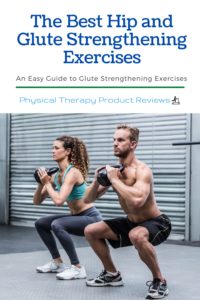 The exercises listed below are great. They are easy, require no equipment other than an inexpensive bands and really really work. You will be amazed at how hard these are and how much of a burn you get from these simple exercises.
The exercises listed below are great. They are easy, require no equipment other than an inexpensive bands and really really work. You will be amazed at how hard these are and how much of a burn you get from these simple exercises.
The exercises are meant to be done in a ladder type program. Start with the beginner exercises to build a solid foundation. You don’t just wake up one morning and run a marathon do you? This is especially true if you are starting a new program, haven’t exercised in a long time, or have a fresh new hip injury. Work your way up the ladder to the intermediate and then to the advanced exercises over several weeks. If you have any questions be sure to let us know!
The Best Glute Exercises for Beginners
The beginner glute exercises are great for anyone that is new to exercises, hasn’t done any exercises for a long period of time, or is recovering from a recent injury. These exercises are also great for seniors looking to gain stability in their hips and stay active. These are generally low impact and can be performed in the comfort of your own home with the use of a resistance band:
These exercises are often some of the same exercises performed in the early stages after an injury and after most hip surgeries ( Always check with your favorite Physical Therapist first!)
Side Lying Clamshells
The Clamshells are a clinical favorite. This exercise targets the deep hip rotators such as the Piriformis and helps activate the Glute max. This is a great exercise for anyone having difficulty with lower extremity alignment.
HOW TO PERFORM:
- Lie on your side with your knees bent and a small resistance band wrapped around your legs just above your knees.
- Bring the top knee up towards the ceiling while keeping contact of your feet together
- Try not to let your pelvis and trunk roll backwards during the movement.
Side Lying Hip Abduction with a Band
The side lying hip abduction exercise is the go to for early hip abductor strengthening. This exercise targets the Glute Medius, Glute Minimus, and the TFL. Another great exercise for early hip stability and targets one of the most commonly weak muscle groups is the general population.
HOW TO PERFORM:
- Lie on your side with the bottom knee slightly bent. Slowly raise up your top leg to the side or towards the ceiling.
- The movement should be up and slightly backwards, don’t let your heel come forwards past your hip
- Keep your knee straight and maintain your toes pointed forward the entire time.
Side Steps with a Resistance Band
This one burns! This is a great exercise to also target the hip abductor muscles and is great to help with hip and lower leg alignment. This does not take much to really feel the muscle burn!
HOW TO PERFORM:
- Place a small resistance band around your feet, just above your ankles
- With your knees slightly bent and toes pointed forward, step sideways 10-15 feet
- Try to maintain tension in the band the entire time by taking a big step with the front foot and a smaller step with the back foot.
- Try to maintain the mini squat and toes forward the whole time
Standing 3-Way Hip Strengthening with a Band
The most functional of the beginner level exercises. This exercise is a great way for people to target 3 of the 4 muscle groups in the hip in a short amount of time. Minimal space and equipment needed and you are going to be surprised at how much you feel it in the stance leg!
HOW TO PERFORM:
- Stand with a mini resistance band around the ankles.
- Try to maintain your hips levels during the whole movements and the legs straight with your toes pulled up towards the shin on the moving leg.
- With the leg straight, move it to the front, side and back.
- Make sure to keep the trunk upright in all three directions.
- Try to move slow and controlled to really get the most benefit from the exercise
Need a set of resistance bands? See our reviews on the Best Resistance Bands on Amazon.
The Best Intermediate Glute Exercises:
Monster Walks with a Band
The monster walks are a favorite within the clinic. There are so many different variations that be used to make this harder. This exercise works the hip extensors, abductors, and hip flexors all in one exercise.
HOW TO PERFORM:
- Start with a resistance band around both ankles
- Walk forward while keeping your feet spread apart and tension on the band and move forward 15 feet. Then walk backwards the same distance and keep the feet apart.
- Keep your knees bent the entire time.
Glute Bridges with Band
An underestimated exercise that can really work the glutes. Helps with strengthening the hip extensors, can help strengthen the low back and is a great exercise for someone with tight hip flexors.
HOW TO PERFORM:
- Start by lying on your back with a small resistance band around your knees and pull your knees apart to tighten the band.
- Hold this position, tighten your lower abdominals, squeeze your but muscles
- Then slowly raise your hips off the floor and maintain a bridge for 2 seconds
Fire Hydrants with a Band
The fire hydrants are a favorite exercise to warm up with within the clinic. This targets the hip abductors on both hips and helps with spinal stability! It’s a great quadruped exercise the teach neuromuscular education, or in simpler terms, it teaches your body how to move correctly once again.
HOW TO PERFORM:
- Start in a quadruped position with a small resistance band around your thighs just above your knees.
- Next, raise your leg out to the side without rotating the spine
- Maintain a straight upper and mid back throughout the movement and it may be best to watch yourself in the mirror
Glute Donkey Kicks with a Band
Another great quadruped exercise to target the hips and the low back. The position of the exercise really allows to isolate the glutes and the spinal extensors.
HOW TO PERFORM:
- Start in quadruped with a resistance band around your thigh just above your knee.
- In a controlled manner, extend your hip up toward the ceiling while you simultaneously straighten your knee and hip
- The leg motion is in a diagonal pattern leading with the heel.
- It’s an easy exercise to compensate on so make sure to keep your spinal straight, tighten your abdominals, and try to prevent your back from arching
Jumping Jacks with a Band
This exercise targets the hip abductors and the cardiovascular system. This is much harder to do than it looks or sounds. This is best performed with a tighter resistance band than you might use for some of the other exercises. A huge booster for the cardiovascular system which can play a significant role in chronic pain.
HOW TO PERFORM:
- Start in a standing position with hands by your side and feet together. You can place a resistance band around the ankles and the knees or just the ankles
- Next, perform a mini-hop while moving your legs move out to the side.
- Then, hop again and return your hands and feet to original position.
The Best Intermediate Glute Exercises:
Woohoo! You’ve made it to the good stuff! The following exercises are awesome because not only are they fun and challenging to perform but they provide the most value per time spent performing. These exercises typically recruit more muscles, make those muscles work harder, and usually provide a stability challenge. These exercises are great to perform long term because not only do the reduce injury risk but will also help improve your athletic performance.
Single Leg Romanian Dead Lift
One the exercise with the highest EMG activation of the glute medius and glute minimus, the two primary hip abductor muscles. You will feel the burn in the side of the hip and is truly a great whole body exercise:
HOW TO PERFORM:
- Start by standing on one leg with the knee slightly bent.
- During the movement you want to make sure the trunk from hips to shoulders remain square.
- Start by pushing the butt backwards to bend at the hips. You will begin to tip forward towards the floor.
- To rise to the starting position lead with the hips, drive your glute forward, and return to the standing position.
Exercise Band Bulgarian Split Squats
Bulgarian Split squats!! How cool of a name is that? Of my absolute favorite exercises because of the single leg balance, the rotational control of the pelvis, and the amount work on the muscles is so great.
HOW TO PERFORM:
- Stand facing away from a bench or step. Place mini resistance about around the thighs just above the knee.
- Extend one of the legs back and place top of foot that foot on the bench.
- Maintaining a tall posture squat down by bending the knee and hip of front leg until thigh reaches 90 degrees or parallel to the floor.
- Return to starting standing position.
Squats with Leg Lifts
This is a killer exercise especially if you use two bands, one band around the knees and one around the ankles. This targets all 3 of the primary hip muscle grips and also adds in strengthening the cardiovascular system depending on how many reps you do and how fast you do them.
HOW TO PERFORM:
- Start with a band around the knees and a band around the ankles. Bend at the hips first and the knees second moving into a squat position. Don’t let the knees fall to the middle from the bands
- Stop when the thighs reach parallel.
- Strong but controlled, push down through your heels and and raise back up to a standing position. As you are close to the top of the position raise a leg sideways against the band.
- Return to the starting position. Alternate between the legs. Try to do 30-45 repetitions.
Side Plank Clamshells
Ready to get the absolute most bang for your buck? This exercises is great for the core, shoulders, and hips. One of the best whole body exercises that I use with almost all of my athletes. Targets the hip abductors on the bottom leg and the hip external rotators on the top leg.
HOW TO PERFORM:
- Start by lying on your side in a plank position, with your elbow bent and a resistance band around both legs just above the knee.
- Raise your hips to ceiling and keep your body a straight line or a side plank position. Keeping your feet together rotate your top knee towards the ceiling. Slowly lower your knee back down to the other leg. Try to repeat 10 times and then take a break.
- Don’t let the hips sag or the body rotate forwards.
Bosu Ball Lateral Lunges
Another great dynamic exercise that gets a lot of muscles burning. This targets the hip external rotators, the hip extensors and the hip abductors. This is a great injury prevention exercise as the instability of the bosu ball make all the hip stabilizer muscles work extra hard.
HOW TO PERFORM:
- Start with a resistance band around the knees. Begin by standing on one side of the bosu ball and place one foot on top of the ball.
- Push through leg on the floor to bring yourself up and over to the otherside of the bosu ball into a side lunge position. Try to maintain the toes and knee pointing forwards and to land softly.
- Repeat going the other direction. Try to do 30-45 reps in a single session
Other Great Rehab Related Articles
Dealing with Painful Stairs After Ankle Replacement Surgery
Walking After a Total Ankle Replacement: Tips for a Successful Recovery
Exercises While Non-Weight Bearing After Ankle Replacement: Elevation, AROM, Leg Raises, and More
Ankle Pain with Stairs: Causes and Home Treatment Options
5 Common Mistakes You’re Making After an Ankle Sprain
6 Great Ways to Reduce Low Back Pain with Driving
Disclaimer: The information provided in this post is for educational purposes only. This is not a substitute for a medical appointment. Please refer to your physician before starting any exercise program.
